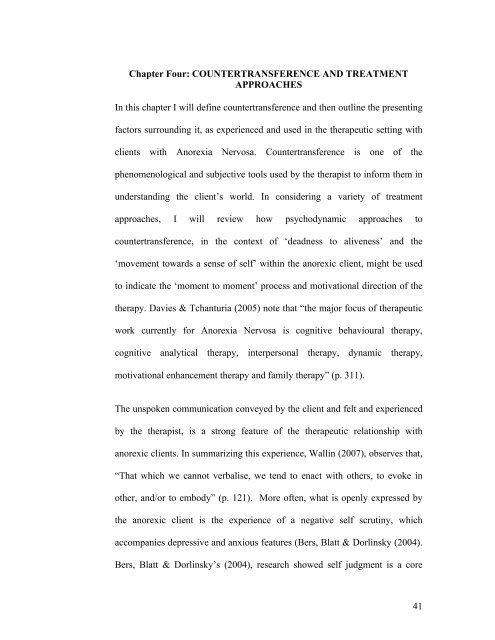“Ghosts at the banquet” - Scholarly Commons Home
“Ghosts at the banquet” - Scholarly Commons Home
“Ghosts at the banquet” - Scholarly Commons Home
You also want an ePaper? Increase the reach of your titles
YUMPU automatically turns print PDFs into web optimized ePapers that Google loves.
Chapter Four: COUNTERTRANSFERENCE AND TREATMENT<br />
APPROACHES<br />
In this chapter I will define countertransference and <strong>the</strong>n outline <strong>the</strong> presenting<br />
factors surrounding it, as experienced and used in <strong>the</strong> <strong>the</strong>rapeutic setting with<br />
clients with Anorexia Nervosa. Countertransference is one of <strong>the</strong><br />
phenomenological and subjective tools used by <strong>the</strong> <strong>the</strong>rapist to inform <strong>the</strong>m in<br />
understanding <strong>the</strong> client’s world. In considering a variety of tre<strong>at</strong>ment<br />
approaches, I will review how psychodynamic approaches to<br />
countertransference, in <strong>the</strong> context of ‘deadness to aliveness’ and <strong>the</strong><br />
‘movement towards a sense of self’ within <strong>the</strong> anorexic client, might be used<br />
to indic<strong>at</strong>e <strong>the</strong> ‘moment to moment’ process and motiv<strong>at</strong>ional direction of <strong>the</strong><br />
<strong>the</strong>rapy. Davies & Tchanturia (2005) note th<strong>at</strong> “<strong>the</strong> major focus of <strong>the</strong>rapeutic<br />
work currently for Anorexia Nervosa is cognitive behavioural <strong>the</strong>rapy,<br />
cognitive analytical <strong>the</strong>rapy, interpersonal <strong>the</strong>rapy, dynamic <strong>the</strong>rapy,<br />
motiv<strong>at</strong>ional enhancement <strong>the</strong>rapy and family <strong>the</strong>rapy” (p. 311).<br />
The unspoken communic<strong>at</strong>ion conveyed by <strong>the</strong> client and felt and experienced<br />
by <strong>the</strong> <strong>the</strong>rapist, is a strong fe<strong>at</strong>ure of <strong>the</strong> <strong>the</strong>rapeutic rel<strong>at</strong>ionship with<br />
anorexic clients. In summarizing this experience, Wallin (2007), observes th<strong>at</strong>,<br />
“Th<strong>at</strong> which we cannot verbalise, we tend to enact with o<strong>the</strong>rs, to evoke in<br />
o<strong>the</strong>r, and/or to embody” (p. 121). More often, wh<strong>at</strong> is openly expressed by<br />
<strong>the</strong> anorexic client is <strong>the</strong> experience of a neg<strong>at</strong>ive self scrutiny, which<br />
accompanies depressive and anxious fe<strong>at</strong>ures (Bers, Bl<strong>at</strong>t & Dorlinsky (2004).<br />
Bers, Bl<strong>at</strong>t & Dorlinsky’s (2004), research showed self judgment is a core<br />
41
















